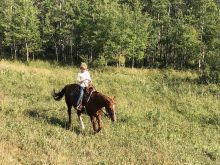For many farmers, an untimely month of rain and snow kept harvest at a standstill in September and October. A fall like this is a hard hit to take on any farm, especially knowing that every day you sat idle waiting to get back in the field cost you big money in lost revenue due to quantity and quality loss of the crops. How is this harvest disruption going to impact your farm’s bottom line this year? How many bushels did you get off, and at what quality and price? Your farm expenses may have increased with added costs for machinery rentals, aeration and drying, unexpected equipment upgrades and repairs.
Read Also

Gentle treatments for pain in the neck
Heading toward year-end, people unknowingly tense up against the cold and busyness, causing neck pain that can often be treated with appropriate support and gentle mobility, athletic therapist Kathlyn Hossack says.
I hope you took time to review those additional costs, so you could decide if it made sense to spend the time and money to do some of those things. Sometimes in the mayhem of the harvest where the focus is on getting the job done, we may not stop to consider if what we are doing is the right thing to do, or if we should be doing something else.
What will give your farm the best net return? Handling tough and damp grain is a time consuming and expensive process. If you have a handling system that allows you to do this efficiently without spending a lot of time moving grain from bin to bin, you should be able to condition your grains for minimal cost and maximize your net returns.
But if you are not set up that efficiently, you may need to spend time figuring out your best options to provide you with the best net return on your farm. What does it cost you — both in time and money — to move grain from bin to bin to dry or aerate it? What do you hope to gain in extra value on a per bushel or per acre basis from doing all this work?
Can you find a buyer who will buy your grain as is for a fair discount, or one that can do the drying for you at a fair cost? In this case, you might end up netting a better price than if you do all the work yourself.
Depending on the situation and the type of grain, I have heard of several instances where grain companies are offering to dry grain at a low enough price that you would have a hard time doing it any cheaper yourself. In that case, why go through all the work if you can pass that job onto the grain company and net out the same value in the end?
If you have canola in the field, find out what moisture levels the crushers are willing to take canola at, and what, if any, discounts they will apply if it is tough. If they’ll take canola in under 12 per cent moisture, that may allow you to start combining a day or two earlier than if you had to wait for it to dry down to 10 per cent. That can make a big difference as to how much canola you get into the bin in a fall like this.
Planning for the worst case
A harvest weather delay is never something you want, but when it does happen, it is a good opportunity to sit back and do some number crunching and run scenarios to see what the potential impact of a harvest wreck would mean for your farm.
Make some contingency plans for “what if” scenarios. Make some calls to buyers and see what they are prepared to do for you if harvest is delayed or your grain is a little tough when you start combining again.
Talk to a neighbour who may be able to dry grain for you if you don’t have a dryer available so you know you will be able to start combining when the grain is close to dry. That extra day of combining can make a big difference.
In a fall like this, it’s going to take long hours to get the harvest done. Doing some pre-planning to try to determine the best way to handle, manage and sell your grains for the best possible net price could save you hours of work and extra expenses, as well as a lot of worry.
















